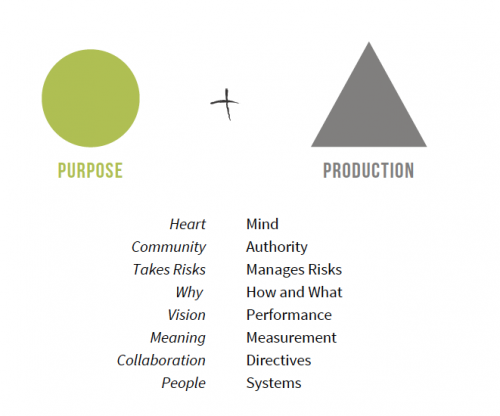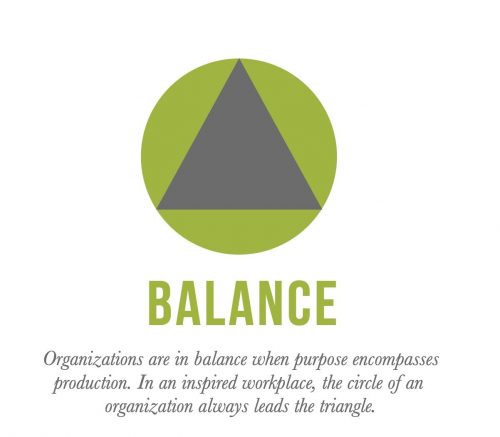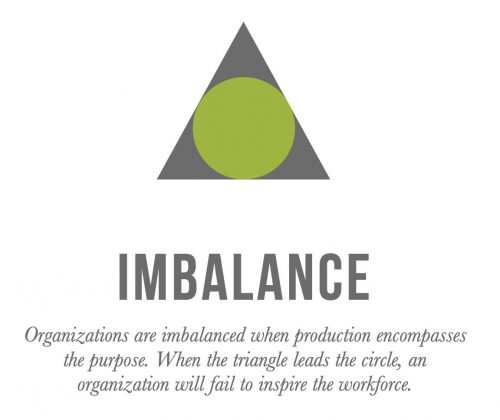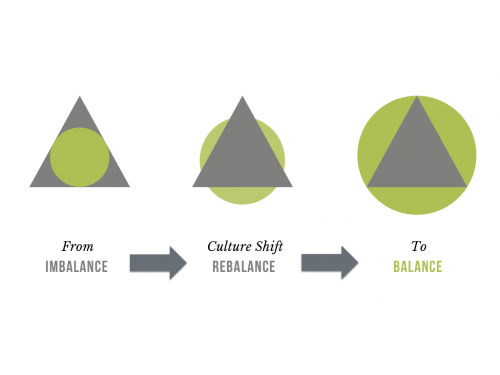The Common Workplace Reality
The team sits down in their predictable spots around the table in a windowless meeting room, flanked on either side by their coffees and buzzing smartphones that serve to divert scarce attention to other urgent matters. Most haven’t seen much of each other since the last meeting. Documents and laptops occupy the remaining table space. Phrases like “the new reality,” “right-sizing” and “critical few” are tossed around as code words to indicate significance and seriousness. Halfway through the stacked agenda, body language tells the story about where the fears and tensions lie, as well as where the battle lines will fall regarding key decisions. Discussion is terse, conversation is disjointed, implications are not considered and each player rehearses a familiar script that everyone else could predict from meetings past. Turf gets vigorously protected, expectations get managed and at the end of the day, everyone hopes they find themselves on the right side of where the buck stops.
Professionals assemble like this day in and day out, keeping our businesses and institutions moving ahead. The reality is that most of these professionals are decent people. They are parents who help with homework, spouses who encourage each others’ dreams, children who care for ailing parents, friends who travel together and share hobbies, neighbours who help one another out and volunteers who coach sports teams. They all behave in such different ways outside of their work environments. They, in fact, have ambitions and dreams of their own and for others. But so often they feel trapped in an inhumane world of work where the battle for power and control is relentless. We are, in fact, these people.
Organizations today need to re-imagine their work cultures and human operating systems so that they can create workplace environments where employees thrive and customers are served exceptionally well.
As noted organizational theorist, Margaret Wheatley, observes,“ After so many years of defending ourselves against life and searching for better controls, we sit exhausted in the unyielding structures of organizations we’ve created, wondering what happened. What happened to effectiveness, to creativity and meaning? What happened to us?”
This leads many to wonder – how can our organizations be different? Organizations today need to re-imagine their work cultures and human operating systems so that they can create workplace environments where employees thrive and customers are served exceptionally well.
It Starts with Purpose
Along with this experience of our everyday workplace, there is a growing awareness of how our world continues to change around us at a rapid pace. Voices like Jeffrey Sachs and Thomas Friedman, among others chronicle global power shifts, the financial, humanitarian and ecological crises we find ourselves in, along with the impact of staggering technology advancements. However, we also recognize how our world needs institutions and organizations of all kinds, including business, to serve a leading role in making the world a better place both globally and locally. It is up to all of us to be on the solution side of the issues.
Given our tepid experiences in the workplace and our hope that there must be a better way, questions are being raised about the purpose of our institutions, organizations and business enterprises: Why do we exist, anyway? Are we still relevant? What, really, are we here for? What difference do we make in this world? Do we really believe in our vision and mission, or are these statements simply a veneer for the profit motive or a cover for self-preservation? In addition, a millennial generation judiciously asks, “Where is an organization that I can really believe in to make my contribution?”
Simon Sinek in his book, Start with Why, explains that employees and clients alike are looking for the compelling reasons for why their organizations do what they do. As he puts it, “People don’t buy what you do, they buy why you do it.” He says that we all long to be inspired by a truly meaningful purpose and be part of something that allows us to share the same dreams, values and hopes that we have. The truth is that many of our organizations struggle to articulate the compelling why of our organization in ways that truly inspire purpose, meaning and hope. And yet many of us long for this ourselves. Simply put, people want to be part of something significant.
More than ever, employees are looking to find personal meaning at work, and for the organizations they work for, to do meaningful work.
If this is true, then leaders need to bring the discussion of why to the forefront in order to renew the fundamental purpose of their organization, and then find ways together with their employees to live this out in everyday world of the workplace. There is a growing chorus of voices who are writing and researching on the topic of purposeful enterprises and workplaces. For example, Sisodia, Wolf and Sheth in their book, Firms of Endearment chronicle how the shift toward meaning-making from materialistic capitalism is taking place in business. Dan Pink in his book Drive says that research surprisingly indicates that what motivates professionals at work is much more than financial compensation. Rather, he says, we are motivated by experiencing autonomy in our work, by being able to master skills we enjoy and contributing to something meaningful to the world.
We are looking for ways to personally find meaning at work and for our organizations to do meaningful work. How can organizations move in this direction?
Balancing Purpose and Production
The reality is that organizations have core interests that lie in tension with one another. Think about an organization or enterprise as comprised of two shapes: a triangle and a circle.
The triangle represents production and the mind of the organization. Its pointed shape symbolizes its hierarchy with power being centralized at the top where one leader is ultimately responsible for the decisions of the organization. The broadening sides of the triangle represent the chain of command throughout the organization to enable the work functions of the organization to most efficiently produce, sell and deliver a service or product. The triangle emphasizes the effective management of resources and systems and is guided by policy to accomplish very tangible tasks and objectives. The triangle asks, “What must we do?” and “How must we do it?” It ensures that everything can be measured as quantifiable, objective data in order to understand assess performance and achieve results. The triangle clarifies roles, gives titles, grants authorities and assigns dollar valuations on these various functions within the organization. It develops systems and process to ensure production is efficient and effective. Fundamentally, the triangle is what gives the organization its shape and what makes its engines run.
The circle, on the other hand, represents the purpose and heart of the organization. Its rounded shape symbolizes that the organization is a community of people that all have something important to contribute apart from their status in the hierarchy. The circle emphasizes the interdependence of its people and that employees have an identity they bring to work each day that is much more multi-dimensional than their organizational role within the workplace. The circle is aspirational in nature and emphasizes leadership and development of people rather than the management of systems. The circle asks, “Why are we doing this?” It is the heart of the organization that provides vision, inspiration, empathy, courage and creativity. The circle helps the organization understand its own meaning and significance, its history, purpose and values. It tells the story of the numbers. The circle enables the organization to live with ambiguity, move through conflict, cultivate reflection, promote story-telling, foster relationship development, and leads to collaboration. Fundamentally, the circle articulates vision and purpose and then inspires its people to action.
Figure 1. The Relationship Between the Circle and Triangle.

All organizations need both the triangle and the circle to work in balanced partnership. When this happens true organizational purpose informs effective organization function. Balance exists when the organization is living out its values and its mission is expressed as providing some core benefit to society and its customers. Balance exists when leaders put people first and see their primary purpose as serving employees, rather than be served by them. Balance exists when employees take care of the customer and care as much as owners do because they are aligned with the mission and their own sense of purpose. Balance exists when systems and processes are well designed for people to be productive and make meaningful contributions.
Figure 2. A Balanced Organization

A Triangle-Dominated World
However, given the reality of the world we live in, the most common challenge is that the triangle tends to dominate and squeeze out the role of the circle. The triangle will always grow pushing toward imbalance. This is not an unexpected result as we consider the pressures placed upon organizations, including:
- A hyper-competitive marketplace with relentless quarterly performance targets
- Lean resourcing that pressure organizations to do more with less
- Increasing regulation and compliance that pressure organizations to add more layers of bureaucracy that create new complexities and fears of making mistakes;
- Growing complexity of systems and processes that require change and adaptation with increasing frequency;
- Increasing public and stakeholder scrutiny that pressures organizations to expend more energy on managing stakeholder expectations, monitoring its own actions and carefully crafting its messages – much of which is form over substance.
Figure 3. An Imbalanced Organization

The triangle will always grow on its own, pushing toward imbalance.
The net effect is that overloaded managers end up prioritizing what is urgent to stay afloat and focus on achieving short-term results. We lose our way and end up in the service of the systems, structures and numbers rather than using them in service of a larger purpose and vision. When purpose gets lost, agendas become selfish and people get trampled over. You end up in a meeting where someone asks an appropriate why question and the leader snaps, “Because that’s what we’ve been told and we’ve always done it that way.” Innovation and creativity get sideswiped. The means become the ends.
If leaders do not tend to the circle organizations will grind down their employees, lose productivity, leak vision, diminish attractiveness to best talent and slow down innovation. A lot it is at stake.
However, there are ways to restore this balance and that can lead to long-term, sustainable organizational health.
Expanding the Circle to Fit the Triangle
In order for organizations to be successful over the long term, they need to be places for people to flourish as they do the work of the organization. Leaders must develop workplaces as communities that equip, empower and inspire employees to live out the purposes of the organization within the realities of the triangle. To regain balance the circle to expand so that it can re-balance with triangle.
Figure 4. Rebalancing the Organizational Culture

The circle will not grow unless leaders cause it to grow, bringing the organization back into balance.
It is the role of leaders to ensure that the organization is in balance. The triangle will always grow on its own pushing for imbalance but the circle will not grow unless leaders cause it to grow.
Leadership Can Shift the Culture Toward Balance
How do leaders do this? Leaders must be able to develop competencies, mindsets and behaviours that support the development of employees – precisely to navigate the triangle by equipping them with the circle. These are akin to the time-tested, classic Servant Leadership principles, articulated by Robert Greenleaf decades ago.
A concise way to articulate four core leadership competency themes for leaders who shift the organizational culture toward balance:
Inspiration: Moving employees beyond engagement to act more like ‘owners’ than ‘renters’. Inspired employees buy into the larger purpose and are motivated by their big picture even as they engage in operation activities.
Accomplishment: Establishing high-trust environments where everyone is accountable for their actions and performance. It enables collaboration and coordination cross the organization, reducing turf protection and rivalries, so that the desired outcomes get accomplished.
Empowerment: Ensuring employees receive regular coaching, feedback, knowledge and encouragement so that they can grow in their skills, experience and knowledge, adding greater value to the organization. It is about humanizing the work relationships.
Adaptability: Creating a culture that is adaptive, quick to identify shifts and an openness to change where needed. It is about rewarding healthy risk-taking that is at the foundation of innovation.
Leaders need to be engaged in ongoing leadership development to grow in these competencies. In fact, the way leadership development happens can itself be a shift to the culture.
Leadership Development Through Peer Learning Methodology
A very successful way to cultivate leadership capabilities is by using a peer learning methodology called Leadership Circles.
Leadership Circles are facilitated, peer-based learning groups of up to ten leaders within an organization that gather together on a regular basis to learn about essential leadership topics, reflect upon their own leadership, discuss their experiences in the workplace, give and receive constructive feedback and seek to apply their learning discoveries.
Leadership Circles are way to foster leadership learning in the workplace that offers built–in support and helps to reduce the ‘support vacuum’ that leaders experience in many organizations. Managers, at all levels have the chance to learn and reflect on vital topic themes, but even more importantly find an open learning space where they can bring their day-to-day challenges and success to the circle for discussion. This reflection and learning with peers leads to practical application and the regular frequency creates built in accountability and trust development among leaders. It leverages on-the-job experiences and is more cost-effective and impactful than standard class room learning can provide.
Leadership Circles Serve Two Fundamental Purposes
- They are designed to be ‘culture incubators’ to help participants move toward the culture and values that the organization is shifting toward. Participants are then encouraged to put their learning into action and operational discoveries with their teams to be ‘culture carriers’.
- They are designed to cultivate leadership influence capabilities. Leaders in this context will be defined by internal qualities such as ‘servant leadership’ or ‘leading through influence’ rather than by position per se. In this capacity, they will be encouraged to influence the organization in moving toward the shifts identified.
Leadership Circle Format:
Typically, Leadership Circles are adapted to each organization in unique ways, however, the format most often includes:
- 1 or 2 facilitators with a total of 8-10 people
- 2-3 hour gatherings approximately 8-10 times per year (once every 4-6 weeks)
- Curriculum with world-class content on topics of leadership and organizational culture
- Not a work “meeting”, but referred to as a “gathering” in a relaxed, casual setting
- Participants come as persons first, workplace colleagues and professionals second
- Space for reflecting, listening and processing lived experiences of leadership
- Space for generative discussion on how to improve leadership practice
- Application to new behaviors for the workplace
Design Principles of Leadership Circles:
- Psychological Safety: A vital aspect is the environment of psychological safety where participants can be themselves both personally and professionally. Participants learn best in environments where they feel accepted and can be transparent about their leadership experiences – good or bad.
- Leadership Reflection and Tools: As professional learning environments, leadership circles offer relevant curriculum as well as time and space to reflect on how this learning relates to their work experience. This is not a training program, but rather a facilitated peer learning environment that combines didactic as well as experiential learning.
- Peer Learning and Support: There is a growth trajectory not only for individuals but also for the group itself. Peer learning conversations help support the growth of individual participants but also allow the group to identify areas where the organization must make shifts in behaviors and organizational habits. There areas of learning then spin off into teams and work units to drive culture change more deeply into the organization.
What are the Characteristics of Leadership Circles?
There are several important characteristics of Leadership Circles:
- An Environment to Learn and Grow: Leadership Circles are led by a facilitator or pair of facilitators, who provide the necessary leadership to create a safe environment for the its participants to be real and transparent about their work experience. They help the group establish trust by setting the tone and developing a ‘rules of engagement’ to safe-guard the trust. They provide focus and structure for the Leadership Circles gatherings (not called ‘meetings’) and facilitate discussion among group participants. What is even more important is that they model authenticity by being real and transparent about their own experiences. If the facilitators take the risk of being vulnerable among the group, others will see that it can be a safe place for themselves to be real as well. They are not expected to be experts in leadership or to be trainers, nor are they expected to be senior leaders in the organization. Each facilitator is carefully selected and then is equipped for the role, with the requirement of having prior experience in a Leadership Circle. True personal growth can’t come without vulnerability and risk, and this must be modeled first in order for others to follow.
- A Place to Belong in the Workplace: These groups can be composed of employees from within a work department, gathered from across functions, and also be a cross-section of the management hierarchy of the organization. It is important to have staff mixed together in ways that enable them to speak freely about their work experience (ie. no direct reporting relationships in the same group). Employees are invited to participate voluntarily and no one is required to join a group. In fact, participants join an Leadership Circle as a member of the organizational community where, in this setting, all are welcomed as equals. Participants are asked to make their job identity secondary to their personal identity so that any possible power dynamics are minimized. This setting is intended to be an alternative culture to the every-day work setting so that participants can learn to be different people when they return. When people feel they belong in an organization, they behave in ways that demonstrate personal ownership of the mission they serve.
- A Leadership That Inspires: Leadership Circles have a very particular understanding of leadership that is important to understand. Leadership in this context is defined as leadership through influence (relational) versus leadership through power (positional), and aligns with what is classically understood as ‘servant leadership’, first popularized by Robert Greenleaf. In other words, leadership gets democratized and becomes something that everyone can participate in. Circle participants are challenged to consider how they can use their influence and expertise to bring positive change to the organization, even if they do not have a formal leadership or management role. It is an expression of leadership that invites employees to lead courageously and authentically from the heart and call out the best out of one another in service of the purpose for the organization. When a person discovers that he or she can use their influence to affect positive change to their organization, they see a whole new dimension of purpose in their work.
- A Forum to Drive Applied Learning: One the biggest benefits of creating a safe space is that participants can express, explore and respond to their areas of insecurity, fears, mistakes and missteps, without reprisal. Common elements of gatherings include time to think and reflect, a time to check-in with each other (“How are you doing, really?”), as well as candid and transparent discussion about how themes that are raised may apply to each group member. This is not another training exercise with information about leadership or management left unapplied, nor is it an ungrounded feel-good exercise. Our observation is that employees in organizations are already saturated with information and training and, in addition, have no patience for superficial group-building exercises. Rather, they hunger for a protected space where they can identify ways to put learning into action within the gritty context of their everyday work lives. A circle experience is like a great conversation that leaves participants more aware of themselves, their impact on others, more energized and better prepared to face the challenges in their day-to-day work.
What is the Impact of Leadership Circles?
Involvement in Leadership Circles can lead to incredible transformation happen in the lives of participants and on the organizations they serve. Impacts include the following:
- More Authentic Leadership: Participants have been far more open than anticipated and are making changes to the way they manage their teams and projects. Managers are more likely to admit mistakes and be transparent with their team. In addition, some have been emboldened to face conflict on their teams by having open, honest discussions and being firm when necessary without using power coercively. As they have done this, they more often helped to positively transform a situation, rather than to simply contain it.
- Improved Organizational Trust: The strengthening of informal networks within organizations is one of the most powerful ways to grow trust within the organization. Participants grow relationships with others that leads to collaboration and act as resources to support one another with their respective skills, knowledge and experience.
- Effective Talent Management: Managers learn how to identify and better utilize the talent on their teams because of the engagement skills they have improved. Some have recognized new abilities in their staff and retained them because they provided them with new opportunities to grow and challenge themselves.
- Innovation and Quality Improvement: Participants have gone back to their teams to identify ways to innovate service delivery and management systems, unprompted. Our experience has been that the safe space created has enabled staff to imagine new ways of approaching old problems. When one person discovers, “Oh, I’m not the only one with this problem” it is amazing how shared ideas and experiences shape new approaches.
- Deeper Engagement and Improved Morale: Participants are re-entering their work with deeper engagement and increased motivation because they can see how their role is linked with the impact on external and internal clients and the overall purpose of the organization. The data shows that those involved in Leadership Circles showed higher employee engagement. It is because they have been empowered and called into a higher responsibility for bringing about positive change in the organization that participants share greater ownership of the mission and vision.
Summary
Organizations are increasingly looking to develop their leaders to be responsive the new demands and expectations of the workplace today, to and create workplace cultures that allow leaders and workers to thrive.
Our lives in the triangle must be tempered with circle experiences that serve to renew employees and leaders in workplaces. And this in turn leads to workplaces that are effective in accomplishing their mission – precisely because people have been empowered to live out the ‘why’ of their organization and their lives.
What is the next step for your organization and your own personal leadership development?
